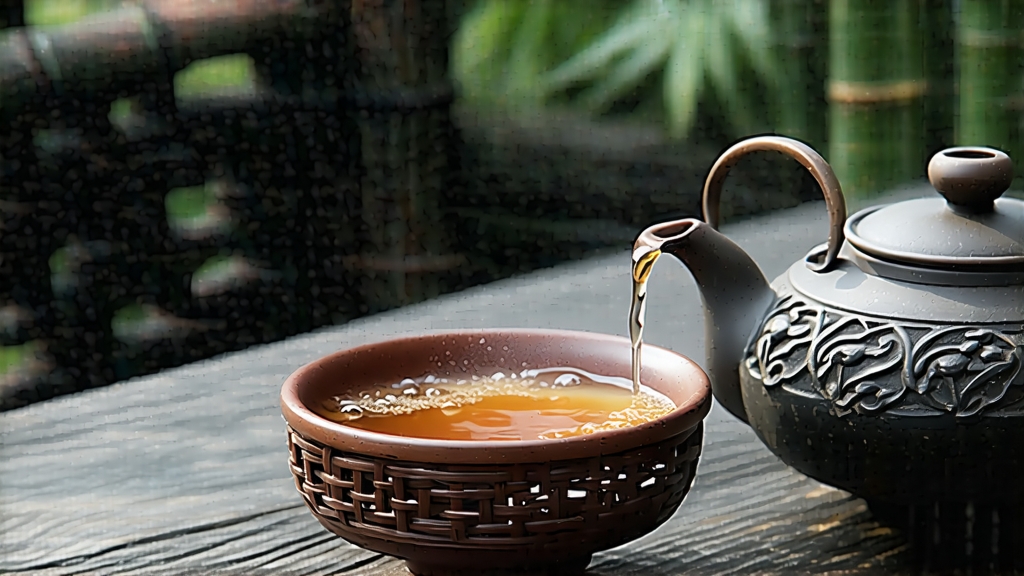
Liu Bao cha, literally “Six Forts tea,” is the quiet diplomat of China’s dark tea family. While Pu-erh grabs headlines, Liu Bao has spent four centuries fermenting in the mountain folds of Guangxi Province, emerging with a flavor that once accompanied coolies down the Mekong and perfumed the counting houses of Hong Kong. Today it is experiencing a renaissance among specialty drinkers who prize its deep, betel-nut sweetness and its ability to age like a Burgundy yet remain affordable to the curious.
History: From Border Garrison to Global Cup
The name refers to the six defensive forts built during the Ming dynasty along the Guangxi-Guangdong frontier. Caravans carrying tea, salt and copper stopped here, and the pressed leaf they carried was already dark, its enzymatic life subdued by months of monsoon travel. By the Qing, Liu Bao was listed in the imperial “Tea Tax Gazette” as a commodity shipped south to Malaya and north to Mongolia. In 1886 the British consul in Wuzhou noted “a black tea of unusual fragrance, pressed into baskets smelling of wet earth and cinnamon,” the earliest Western mention. The opening of the Hong Kong–Canton rail line accelerated export; by the 1930s more than 3,000 tons a year left Wuzhou docks, most destined for tin-mine workers who believed the liquor prevented malaria and cooled internal heat. After 1949 the state re-organized production into the Wuzhou Tea Factory, standardizing the once-home-spun process and creating the numbered recipe system still used. When Malaysia’s economy boomed in the 1970s, Liu Bao returned across the South China Sea, filling the bamboo baskets of Kuala Lumpur tea merchants who now sell vintage 1958 bricks for four-figure sums.
Micro-terroir: The Subtropical Cellar
Liu Bao is born between the Tropic of Cancer and the Yunkai Mountains where the West River squeezes through granite gorges, creating a 75–85 % relative humidity year-round. The cultivar is a large-leaf Camellia sinensis var. sinensis locally called “Yao Shan Zhong,” a genetic bridge between the Assamica of Yunnan and the small-leaf bushes of Fujian. Spring mornings wrap the gardens in fog so thick that photons seem to slow; the leaves respond by thickening their cuticle, storing more polyphenols and caffeine, the biochemical precondition for the microbial drama that will follow.
Craft: The Double Fermentation
Unlike Pu-erh’s wo-dui invented in 1973, Liu Bao’s “wet piling” predates it by three centuries. The process begins with sha-qing (kill-green) in a 200 °C wok for four minutes—longer than green tea, shorter than oolong—arresting oxidation but leaving a stubborn 12 % moisture. The bruised leaf is then piled 70 cm deep inside bamboo steamers set on wooden racks in an underground chamber called a “fermentation cellar.” The floor is bare earth, sprayed with river water drawn from the Xun Jiang whose mineral load carries Clostridium and Bacillus species native to the region. A jute tarp is thrown over the pile; internal temperature climbs to 55 °C within 36 hours. Every three days a team of “turners” forks the heap, introducing oxygen and redistributing heat, a ritual repeated for 25–35 days until the leaf turns chestnut-brown and emits the signature aroma of damp bark, nutmeg and betel quid. After piling the tea is steamed, pressed into 40 kg bamboo baskets lined with banana leaf, and moved to an above-ground warehouse for the second, slower fermentation. Here the baskets are stacked cross-wise, allowing airflow; every six months the factory sampler inserts a long iron needle, withdraws a core, and grades the tea on color, aroma and “throat activity.” A top-grade Liu Bao will cycle through this warehouse for at least three years before release, but connoisseurs seek baskets left untouched for decades, the leaf darkening to obsidian, the flavor evolving from fruity to camphoraceous to the elusive “old library” note prized in Hong Kong auction rooms.
Grades & Shapes
The state standard GB/T 32719.4-2018 divides Liu Bao into five grades, but the market speaks in basket codes: 0212 (light